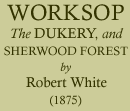< Previous | Contents | Next >
Hamlets in the parish of Worksop
Rayton and Manton
Rayton.
Rayton is another ancient hamlet of the Parish of Worksop, the property connected with which has for a considerable time been united with the Scofton estate. It formerly, however, constituted a separate domain, with its Hall and resident gentry. Indeed, we learn from the Domesday survey that before the conquest there were two manors here, respectively held by Vlsi and Archil. These, after that event, became the property of Roger, the tenant of the great Roger de Bush, whose fee it had become. There was then also another portion of land here, which was waste; and besides these, as we have already seen, speaking of Scofton, there was a part belonging to the King’s manor of Mansfield. In Domesday survey it appears under the designation of "Rolvetune" and "Rouuetone." Very little is known of its subsequent history for several centuries; we, however, catch a glimpse of it in a plea 30 Edward I., referred to by Thoroton, from which it appears that "Stephen Malovel gave a messuage, 260 acres of land, and seven of meadows in Renetone, nigh Wirksop, to Alice, the wife of Ranulph de Huntingfeld, who bound himself to John de Melsa in c. marks by a statute merchant, and failing in payment the Sheriff caused the land to be extended at a reasonable price, viz., £4 9s. 1d., and put the said John in seizin, in which he stood for a year and more, until the said Ranulph and Alice disseized him, &c. Upon which came William de Dogmerfeld, who said he was the King’s Bailiff of his manor of Maunsfeld, and that Renetone was a member of the King’s said manor, and the tenements put in view; ancient demesne, &c."
When Thoroton wrote, and for four generations previously, Rayton was the residence and the property of a branch of the widely spread family of Eyre. They originally proceeded from Hope, in the Peak of Derbyshire; and in the early part of the 15th century Robert Eyre married the heiress of Padley, of Padley, in the same county, from whom were born eleven sons, most of whom had families. From Roger, the fourth of these, descended the Eyres of Newbold, Laughton, Grove, and Rampton; and from Edmund another son, the Eyres of Rayton. They appear to have acquired this place by the marriage of William Eyre to Ann, the daughter and heiress of the possessor of Rayton. At the time of Harrison’s survey, 1636, Mr. Robert Eyre was the proprietor, who married a daughter of William Saunderson, of Blyth, and niece of the celebrated Dr. Robert Saunderson, Bishop of Lincoln. By this lady Mr. Eyre had a rather numerous family; but they appear not to have continued much longer at Rayton. It afterwards became united with the Scofton estate, and is now the property of Mr. Foljambe. The whole of it has been rented for several generations by the family of Outram, also of an ancient Derbyshire race long seated at or about Dronfield. Mr. H. Outram, the present occupant, dwells in a pleasantly situated farmhouse, which, together with two or three cottages, form the hamlet. The ancient Hall stood in a much lower situation near the river, but of it not a stone remains.
The farms of Rayton and Kilton are bounded on the north by a lane bearing the ominous name of Thievesdale, which here separates the parishes of Worksop and Carlton.
Near the intersection of Thievesdale with the Blyth road at this point is Forest Hill, the pleasant residence and property of Robert Owtram, Esq., and beyond this, on more elevated ground, is Prospect Hill, a farm bel6nging to J. Vessey Machin, Esq. This latter place is rightly denominated, as it commands very extensive views, including, on a clear day, the distant towers of Lincoln Minster. Here, at the Ordnance survey of the country, one of the Trigometrical stations was placed.
Manton.
Manton was an ancient member of the Conventual property of Worksop. It is separated from Rayton and Kilton by the river Ryton. Richard de Lovetot, the son of the founder of the Priory, gave here "the mill and the fishpond;" but either he or some one after him must have given much more, for although it is stated that Francis, Earl of Shrewsbury, after the dissolution, received in exchange for other property, amongst other things, "Four acres of arable land in Manton in the Parish of Worksop, &c.," yet it seems clear that this last item—the &c.—must be accepted in a very expansive sense, unless some subsequent grant or purchase was made; for at the time of Harrison’s survey in 1636, within a century of the Earl of Shrewsbury’s grant, the property of the Priory here, then in possession of the descendants of the Earl, was no less, including Sheep-walks (924a. 1r. 2p.), than 1284 acres.
Manton is now a farm of the Worksop Manor estate, under the tenancy of Mr. G. R. Lucas, having a pleasantly situated and good farmhouse built about 50 years ago by the then tenant, Mr. W. Gregory.
